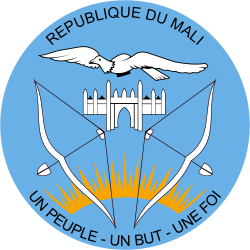2020 Malian parliamentary election
Parliamentary elections were held in Mali on 29 March 2020, with a second round on 19 April.[1] They were initially scheduled to be held on 25 November and 16 December 2018,[2] but were moved to April 2019 and then to June 2019,[3][4] before being postponed until 2020 by the Council of Ministers.[5] The elections were marred by violence in the north and center of the country.[6]
| |||||||||||||||||||||||||||||||||||||||||||||||||||||
All 147 members of the National Assembly | |||||||||||||||||||||||||||||||||||||||||||||||||||||
|---|---|---|---|---|---|---|---|---|---|---|---|---|---|---|---|---|---|---|---|---|---|---|---|---|---|---|---|---|---|---|---|---|---|---|---|---|---|---|---|---|---|---|---|---|---|---|---|---|---|---|---|---|---|
| |||||||||||||||||||||||||||||||||||||||||||||||||||||
| |||||||||||||||||||||||||||||||||||||||||||||||||||||
 |
|---|
| This article is part of a series on the politics and government of Mali |
|
Parliament
|
|
Administrative divisions
|
|
|
|
These are the first elections to fill Mali’s 147-seat parliament since 2013.[7]
Thousands of Malians have died as the country suffered sporadic attacks by jihadists as well as cases of inter-ethnic violence since unrest began in 2012.[7]
Electoral system
The 147 members of the National Assembly are elected from 125 constituencies using the two-round system to serve five-year terms. In constituencies where there is more than one seat, block voting is used.[8]
Conduct
Leader of the opposition Soumaila Cissé was kidnapped on 26 March, three days prior to the elections.[9] Village chiefs, election officials, and an election observer were kidnapped; there were death threats and a police station was ransacked according to the Coalition for the Observation of Elections in Mali, which had sent 1,600 observers. Nine people were killed when their vehicle hit a landmine on 29 March. Three soldiers were killed and three injured in another landmine on 30 March. An al-Qaeda-aligned group took responsibility for the bombings, as well as an attack on soldiers and the killing of a group of Dozo hunters on 27 March.[6]
Results
Parties formed different alliances in different constituencies, making it impossible to determine a national set of vote figures.[10] The election continued a decades-long trend of turnout being under 40% in the country, and the first-round elections were marred by violence in the north and center of the country.[6]
| Party | Seats | ||||||||
|---|---|---|---|---|---|---|---|---|---|
| First round |
Second round |
Total | +/– | ||||||
| Rally for Mali | 10 | 41 | 51 | ||||||
| Alliance for Democracy in Mali | 2 | 22 | 24 | ||||||
| Union for the Republic and Democracy | 4 | 15 | 19 | ||||||
| Movement for Mali | 0 | 10 | 10 | New | |||||
| Democratic Alliance for Peace | 3 | 3 | 6 | ||||||
| Convergence for the Development of Mali | 0 | 5 | 5 | ||||||
| Alliance for Solidarity in Mali | 0 | 4 | 4 | ||||||
| Union for Democracy and Development | 0 | 4 | 4 | ||||||
| African Solidarity for Democracy and Independence | 1 | 2 | 3 | ||||||
| Yéléma | 1 | 1 | 2 | ||||||
| Party for National Renaissance | 0 | 2 | 2 | ||||||
| Democratic Social Convention | 0 | 2 | 2 | ||||||
| Party for the restoration of Mali's values | 0 | 1 | 1 | ||||||
| Malian Union for the African Democratic Rally | 1 | 0 | 1 | ||||||
| Party for Economic Development and Solidarity | 0 | 1 | 1 | ||||||
| Alliance for the republic | 0 | 1 | 1 | New | |||||
| Patriotic Movement for Renewal | 0 | 1 | 1 | ||||||
| Union of democratic forces for progress | 0 | 1 | 1 | ||||||
| Mali kanu Party | 0 | 1 | 1 | New | |||||
| Socialist Party Yelen Kura | 0 | 1 | 1 | New | |||||
| Other parties | 0 | 5 | 5 | - | |||||
| Independents | 0 | 2 | 2 | ||||||
| Votes cast | First round | Second round | |||||||
| Votes | % | Votes | % | ||||||
| Valid votes | 2,603,157 | 95.48 | 2,186,077 | 92.67 | |||||
| Invalid/blank votes | 123,135 | 4.52 | 172,832 | 7.33 | |||||
| Total | 2,726,292 | 100 | 2,358,909 | 100 | |||||
| Registered voters/turnout | 7,663,464 | 35.58 | 6,691,305 | 35.25 | |||||
| Source: Constitutional Court, Full results, MaliWeb CC 2nd round Full results 2nd round | |||||||||
References
- "Mali: first round of legislative elections set for March 29". Jeune Afrique. 23 January 2020. (in French)
- AFP, Le Figaro fr avec (2018-09-13). "Mali: les élections législatives reportées d'un mois". Le Figaro.fr (in French). Retrieved 2020-01-02.
- "Mali: Legislative elections postponed to June 2019 /update 16". GardaWorld. Retrieved 2020-01-02.
- Welle (www.dw.com), Deutsche, Mali: les vraies raisons du report des législatives | DW | 16.10.2018 (in French), retrieved 2020-01-02
- "Mali : adoption d'un projet de loi prolongeant le mandat des députés jusqu'en 2020". JeuneAfrique.com (in French). 2019-06-08. Retrieved 2020-01-02.
- "Malian parliamentary elections marred by kidnappings, attacks". Al Jazeera. March 31, 2020.
- Elections Continue in Mali Despite Virus, Violence Fears
- "IPU PARLINE database: MALI (Assemblée Nationale), Electoral system". archive.ipu.org. Retrieved 2020-01-02.
- Mali opposition leader abducted with campaign team in north Associated Press/ABC News, 26 March 2020
- Republic of Mali legislative election of March–April 2019 Psephos